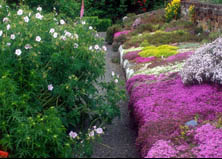A spring visit to Harlow Carr garden
 On Thursday I joined a Press Briefing Day to the RHS Harlow Carr Garden near Harrogate that was arranged by the Garden Media Guild, a lovely spring day of sunshine and blue skies. I haven't been to the garden for a few years and there have been many developments; the old, small alpine house demolished and a new one built on rising ground looking down into the valley and the woods beyond. It's not quite open yet but we had an early look, the inside being artfully laid out with alpines nestling among rock and gravel beds, the outside ready to be planted with more alpines in two long raised borders. This view shows the new structure seen through the lattice of woven willowwork (Phil Bradley, a willow weaver has done many pieces for the garden including a very popular galleon and several arbours)
On Thursday I joined a Press Briefing Day to the RHS Harlow Carr Garden near Harrogate that was arranged by the Garden Media Guild, a lovely spring day of sunshine and blue skies. I haven't been to the garden for a few years and there have been many developments; the old, small alpine house demolished and a new one built on rising ground looking down into the valley and the woods beyond. It's not quite open yet but we had an early look, the inside being artfully laid out with alpines nestling among rock and gravel beds, the outside ready to be planted with more alpines in two long raised borders. This view shows the new structure seen through the lattice of woven willowwork (Phil Bradley, a willow weaver has done many pieces for the garden including a very popular galleon and several arbours)
Down at the streamside, the planting is being redeveloped; some of the old  repetitions are being replaced with more variety and the curious long line of benches all facing the same way like a beachside promenade has gone. It's such a fresh time of year, exemplified by these shuttlecock ferns and skunk cabbage, exuberant, green and lively. In the woodland behind, rhododendrons and camellias were flowering away, rising up against the blue sky. Glades have been opened up in the planting to encourage bats, leaves are left rather than cleared away, all in line with the
repetitions are being replaced with more variety and the curious long line of benches all facing the same way like a beachside promenade has gone. It's such a fresh time of year, exemplified by these shuttlecock ferns and skunk cabbage, exuberant, green and lively. In the woodland behind, rhododendrons and camellias were flowering away, rising up against the blue sky. Glades have been opened up in the planting to encourage bats, leaves are left rather than cleared away, all in line with the
policy now of encouraging wildlife. Very few chemicals are used at Harlow Carr, none in the lawns (brilliant, I think!) which are considered green spaces, and 100 birds have been counted with a butterfly survey due to take place this year too.
As part of the awareness of the needs of wildlife, the garden shelters have been clad with interesting materials. This was done by Matthew Wilson (see my previous blog) and this is an example - the sides filled in with timbers and stones amongst 
which sedums and ferns have been planted, the roof is planted and a delightful detail is the wooden beam over the door, drilled with holes to encourage insects.


No comments:
Post a Comment